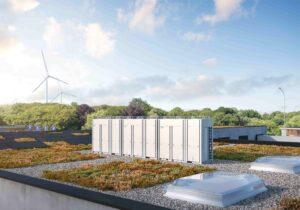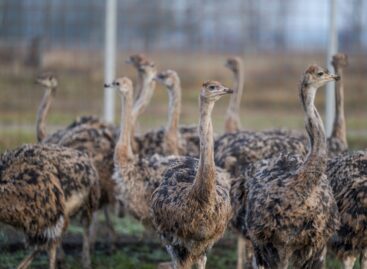World first: Daikin introduces carbon-neutral heat pump
Daikin Europe has officially opened its new Research and Development Centre (EDC) in Ghent, Belgium, where it unveiled the world’s first carbon-neutral heat pump powered by natural refrigerant. The €140 million, 30,600 m² R&D complex serves as Daikin’s global research centre for heat pump heating technologies. The company has increased the recyclability of its entire product range to 80%.
 Daikin has strengthened its presence in Europe by opening a new R&D centre in Ghent, Belgium. The complex, which consists of a 14-storey office building and a 6-storey test building, is built to near-zero energy (nZEB) standards and serves as a development centre for the Europe, Middle East and Africa (EMEA) region. It also serves as the group’s global research center for heat pump heating technologies. The 30,600 m² complex, which was built with an investment of 140 million euros, has 23 advanced test chambers, including a cold chamber in which heat pumps are tested and analyzed at a constant temperature of up to -40 degrees Celsius and 100% humidity. There is also a soundproof room in which work is being done to further reduce the noise level of heat pumps, and a materials testing laboratory in which the behavior of individual components under load is analyzed. The test center also includes an EMC laboratory, which tests electromagnetic compatibility to ensure that heat pumps operate reliably in the presence of electromagnetic interference from the environment and do not interfere with the operation of other devices.
Daikin has strengthened its presence in Europe by opening a new R&D centre in Ghent, Belgium. The complex, which consists of a 14-storey office building and a 6-storey test building, is built to near-zero energy (nZEB) standards and serves as a development centre for the Europe, Middle East and Africa (EMEA) region. It also serves as the group’s global research center for heat pump heating technologies. The 30,600 m² complex, which was built with an investment of 140 million euros, has 23 advanced test chambers, including a cold chamber in which heat pumps are tested and analyzed at a constant temperature of up to -40 degrees Celsius and 100% humidity. There is also a soundproof room in which work is being done to further reduce the noise level of heat pumps, and a materials testing laboratory in which the behavior of individual components under load is analyzed. The test center also includes an EMC laboratory, which tests electromagnetic compatibility to ensure that heat pumps operate reliably in the presence of electromagnetic interference from the environment and do not interfere with the operation of other devices.
World first: Daikin Europe presents carbon-neutral heat pump
At the new R&D center in Ghent, Daikin also presented in detail the world’s first heat pump with a natural refrigerant, the Daikin VRV CO2, with a GWP value of 1. The GWP (global warming potential) value of refrigerants used in air conditioners and other heat pump systems indicates how much a refrigerant would contribute to global warming if released into the environment. The R32 refrigerant currently used by all manufacturers in heat pumps has a GWP of 675, which means that the emission of 1 kg of R32 has a global warming potential 675 times greater than the emission of the same amount of carbon dioxide (CO₂).
The VRV heat pump that Daikin has just introduced has a GWP of 2088 times that of the two most common refrigerants currently in use, R410A, while R32 has exactly 675 times the GWP, as the refrigerant itself is CO2, a natural substance with a GWP of 1. In addition to its low GWP, the CO₂ refrigerant (type code R744) has the additional advantage of being in safety class A1, meaning it is non-toxic during normal use and safe, as it is non-flammable, meaning it will not ignite even from a spark or heat. This device is not a prototype, but is already commercially available: the outdoor unit of the first Daikin VRV CO₂ device has a capacity of 28 kW, while the indoor units are available in four power levels: 4, 5, 6.3 and 8 kW.
Heat pump recycling: close to the theoretical maximum
Daikin has been working for decades to ensure that the residential and industrial heat pumps it manufactures and distributes are made of as much recyclable material as possible, and that the recycling of raw materials into the circular model is as high as possible. Currently, the theoretical maximum for a heat pump device – depending on the type and country – is 90%. Daikin already has a value of 80% for its entire product range – this figure indicates the recyclability of materials such as metals, plastics and refrigerants at the end of their life cycle. In the case of Daikin equipment, the outer metal casings (steel or aluminium) are remelted, the heat exchangers (aluminium and copper) are recovered to pure raw material, the metal parts of the compressors are reused, and some pilot programs are also investigating compressor refurbishment. Plastic parts, such as fan blades, are shredded and processed into new components, and control units (such as circuits) are partially reused and repaired.
In 2019, the company launched a separate program called “Loop by Daikin” for the recovery, regeneration and recycling of refrigerants. The refrigerants used in air conditioners and heat pumps – R-410A, R-134a and R-32 – are recovered, purified to the same quality as the original and reused in new VRV systems or commercial and industrial chillers. Since the launch of the program, Daikin has produced approximately 400,000 kg less new refrigerant per year, saving approximately 3,590 tons of CO2 emissions.
Related news
Related news
Record-breaking Black Friday in online orders
🎧 Hallgasd a cikket: Lejátszás Szünet Folytatás Leállítás Nyelv: Auto…
Read more >Campaign launched to dispel misconceptions about meat and dairy products
🎧 Hallgasd a cikket: Lejátszás Szünet Folytatás Leállítás Nyelv: Auto…
Read more >The newest PENNY store opened in downtown Szolnok
🎧 Hallgasd a cikket: Lejátszás Szünet Folytatás Leállítás Nyelv: Auto…
Read more >




